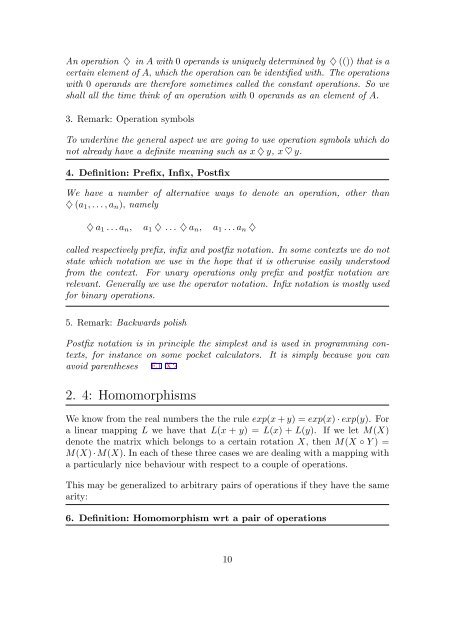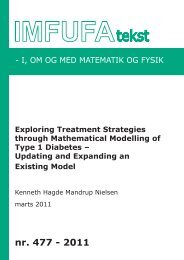ABSTRACT ALGEBRAIC STRUCTURES OPERATIONS AND ...
ABSTRACT ALGEBRAIC STRUCTURES OPERATIONS AND ...
ABSTRACT ALGEBRAIC STRUCTURES OPERATIONS AND ...
You also want an ePaper? Increase the reach of your titles
YUMPU automatically turns print PDFs into web optimized ePapers that Google loves.
An operation ♢ in A with 0 operands is uniquely determined by ♢ (()) that is a<br />
certain element of A, which the operation can be identified with. The operations<br />
with 0 operands are therefore sometimes called the constant operations. So we<br />
shall all the time think of an operation with 0 operands as an element of A.<br />
3. Remark: Operation symbols<br />
To underline the general aspect we are going to use operation symbols which do<br />
not already have a definite meaning such as x ♢ y, x ♡ y.<br />
4. Definition: Prefix, Infix, Postfix<br />
We have a number of alternative ways to denote an operation, other than<br />
♢ (a1, . . . , an), namely<br />
♢ a1 . . . an, a1 ♢ . . . ♢ an, a1 . . . an ♢<br />
called respectively prefix, infix and postfix notation. In some contexts we do not<br />
state which notation we use in the hope that it is otherwise easily understood<br />
from the context. For unary operations only prefix and postfix notation are<br />
relevant. Generally we use the operator notation. Infix notation is mostly used<br />
for binary operations.<br />
5. Remark: Backwards polish<br />
Postfix notation is in principle the simplest and is used in programming contexts,<br />
for instance on some pocket calculators. It is simply because you can<br />
avoid parentheses E1 X2<br />
2. 4: Homomorphisms<br />
We know from the real numbers the the rule exp(x + y) = exp(x) · exp(y). For<br />
a linear mapping L we have that L(x + y) = L(x) + L(y). If we let M(X)<br />
denote the matrix which belongs to a certain rotation X, then M(X ◦ Y ) =<br />
M(X) · M(X). In each of these three cases we are dealing with a mapping with<br />
a particularly nice behaviour with respect to a couple of operations.<br />
This may be generalized to arbitrary pairs of operations if they have the same<br />
arity:<br />
6. Definition: Homomorphism wrt a pair of operations<br />
10
















